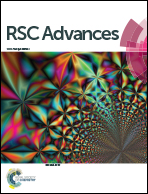Preparation of amidoxime surface-functionalized polyindole (ASFPI) nanofibers for Pb(ii) and Cd(ii) adsorption from aqueous solutions
Abstract
Amidoxime surface-functionalized polyindole (ASFPI) nanofibers were prepared by electrospinning of chemically synthesized poly(5-cyanoindole) followed by surface modification. The as-prepared ASFPI nanofibers were characterized with FTIR, SEM, BET surface areas and water contact angle measurement. Meanwhile, the adsorption properties and mechanism of ASFPI nanofibers towards Pb(II) and Cd(II) in aqueous solution were mainly investigated by a batch method. It was found that ASFPI nanofibers showed a high affinity towards Pb(II) and Cd(II). The maximum adsorption capacities were found to be 307.44 and 108.49 mg g−1 for Pb(II) and Cd(II), which are markedly high values compared to other fiber adsorbents reported. The adsorption isotherms were better fitted with the Langmuir model rather than Freundlich and Temkin models. The kinetics data analysis showed that the adsorption process could be described by a pseudo-second order kinetic model, suggesting a chemisorption process as the rate limiting step. Thermodynamic parameters revealed the spontaneity of the adsorption process and higher temperature favored adsorption. Regeneration tests showed that ASFPI nanofibers could be reused repetitively for 10 times with 80% of the initial adsorption capacity.


 Please wait while we load your content...
Please wait while we load your content...